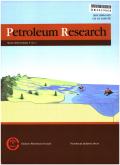CO2结构圈闭的最佳地层深度:盐度的影响
IF 4
Q1 Earth and Planetary Sciences
引用次数: 0
摘要
地质二氧化碳储存被认为是实现净零目标的一个很有前途的解决方案。结构捕集是将注入的二氧化碳保持在储存介质中并防止通过不透水密封/盖层泄漏的主要机制之一。盖层的毛细密封效率也是保证构造圈闭安全的关键。毛细管密封和相关的CO2柱高度由毛细管阈值压力和浮力压力的平衡决定,而浮力压力受CO2/流体/地层性质(即密度、界面张力(IFT)和润湿性)的强烈影响。然而,地下地层通常表现出大范围的盐浓度,并且在润湿性和孔隙半径方面表现出非均质性,这进一步影响了这些关键性质。因此,本研究评估了盐度、润湿性、IFT和孔隙半径对结构捕获效率的影响。分析表明,构造圈闭的最佳储层深度随盐度的增加而减小;例如,在盐度为5 wt%的地层中,在深度约1400 m处观察到最高的CO2柱高度。在不同地层深度和盐度条件下,还建立了新的相关性来量化CO2柱的高度和质量。尽管不同的溶解盐(如NaCl、CaCl2和MgCl2)会影响卤水密度和IFT,但它们对结构俘获的影响可以忽略不计。此外,地层性质的非均质性(即润湿性、IFT和孔隙半径)强烈影响CO2柱高度,导致CO2分布预测的不确定性。本文章由计算机程序翻译,如有差异,请以英文原文为准。
Optimum formation depths for CO2 structural trapping: Impact of salinity
Geological CO2 storage is considered a promising solution to achieve net-zero goals. Structural trapping is one of the primary mechanisms that holds the injected CO2 within the storage medium and prevents leakage via an impermeable seal/caprock. The capillary sealing efficiency of the caprock is also crucial in ensuring the safety of structural trapping. Capillary sealing and the associated CO2 column height are determined by the balance of capillary threshold pressure and buoyancy pressure, which is strongly influenced by the CO2/fluid/formation properties (i.e., density, interfacial tension (IFT), and wettability). However, subsurface formations typically exhibit a wide range of salt concentrations and depict heterogeneity in terms of wettability and pore radius, further influencing these critical properties. Thus, the impact of salinity, wettability, IFT, and pore radius on structural trapping efficiency is assessed in this study. Our analysis suggests that the optimal storage depth for structural trapping decreases as salinity increases; for instance, the highest CO2 column height was observed at a depth of ∼1400 m in 5 wt% salinity formations. New correlations were also developed to quantify the CO2 column height and mass under various formation depths and salinity conditions. Despite different dissolved salts (e.g., NaCl, CaCl2, and MgCl2) influencing the brine density and IFT, their impact on structural trapping is negligible. Additionally, the heterogeneity in formation properties (i.e., wettability, IFT, and pore radius) strongly influences the CO2 column height, resulting in uncertainties in the CO2 distribution prediction.
求助全文
通过发布文献求助,成功后即可免费获取论文全文。
去求助
来源期刊

Petroleum Research
Earth and Planetary Sciences-Geology
CiteScore
7.10
自引率
0.00%
发文量
90
审稿时长
35 weeks
 求助内容:
求助内容: 应助结果提醒方式:
应助结果提醒方式:


